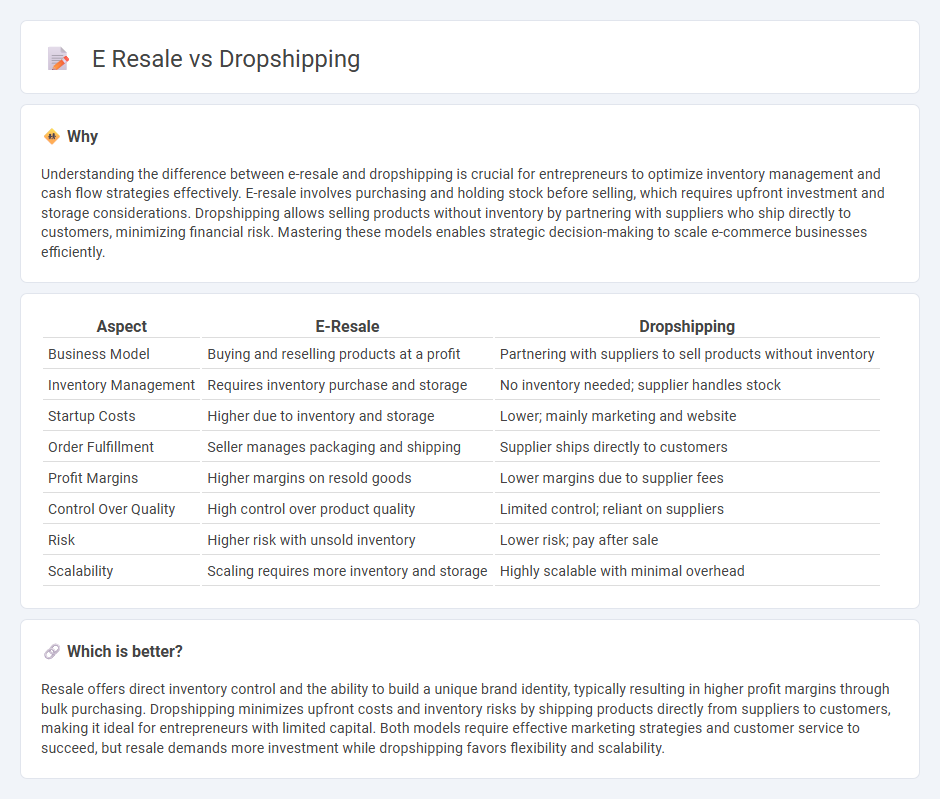
E-resale involves buying products, storing inventory, and selling them online for profit, while dropshipping allows entrepreneurs to sell products without holding stock by directly shipping from suppliers to customers. Both models offer low startup costs and flexible business opportunities but vary in inventory management and profit margins. Explore the advantages and challenges of each to determine the best path for your entrepreneurial journey.
Why it is important
Understanding the difference between e-resale and dropshipping is crucial for entrepreneurs to optimize inventory management and cash flow strategies effectively. E-resale involves purchasing and holding stock before selling, which requires upfront investment and storage considerations. Dropshipping allows selling products without inventory by partnering with suppliers who ship directly to customers, minimizing financial risk. Mastering these models enables strategic decision-making to scale e-commerce businesses efficiently.
Comparison Table
| Aspect | E-Resale | Dropshipping |
|---|---|---|
| Business Model | Buying and reselling products at a profit | Partnering with suppliers to sell products without inventory |
| Inventory Management | Requires inventory purchase and storage | No inventory needed; supplier handles stock |
| Startup Costs | Higher due to inventory and storage | Lower; mainly marketing and website |
| Order Fulfillment | Seller manages packaging and shipping | Supplier ships directly to customers |
| Profit Margins | Higher margins on resold goods | Lower margins due to supplier fees |
| Control Over Quality | High control over product quality | Limited control; reliant on suppliers |
| Risk | Higher risk with unsold inventory | Lower risk; pay after sale |
| Scalability | Scaling requires more inventory and storage | Highly scalable with minimal overhead |
Which is better?
Resale offers direct inventory control and the ability to build a unique brand identity, typically resulting in higher profit margins through bulk purchasing. Dropshipping minimizes upfront costs and inventory risks by shipping products directly from suppliers to customers, making it ideal for entrepreneurs with limited capital. Both models require effective marketing strategies and customer service to succeed, but resale demands more investment while dropshipping favors flexibility and scalability.
Connection
E-resale and dropshipping are interconnected through their reliance on online platforms to facilitate product distribution without traditional inventory management. Dropshipping allows entrepreneurs to sell products directly from suppliers to customers, eliminating upfront stock costs, while e-resale involves purchasing items to sell them digitally at a higher price. Both models leverage digital marketing, e-commerce tools, and supply chain automation to streamline operations and maximize profit margins in the entrepreneurial ecosystem.
Key Terms
Inventory Management
Dropshipping eliminates the need to hold physical inventory by relying on suppliers to ship products directly to customers, reducing overhead and risk. In contrast, eResale requires managing and storing inventory, which involves costs for warehousing, stock control, and potential unsold goods. Explore detailed strategies for effective inventory management in both models to optimize your business operations.
Supply Chain
Dropshipping eliminates inventory holding by directly shipping products from suppliers to customers, resulting in a leaner supply chain with minimal upfront investment. E-resale involves purchasing and storing inventory before selling, creating a more complex supply chain with inventory management and warehousing needs. Explore the detailed differences in supply chain strategies between dropshipping and e-resale to optimize your business model.
Profit Margin
Dropshipping typically offers lower profit margins, often ranging between 10-30%, due to direct supplier shipping and minimal inventory costs. E-resale allows sellers to buy products in bulk at wholesale prices, enabling higher profit margins of 30-60% through control of inventory and pricing strategies. Explore detailed comparisons and best practices to maximize your earnings in both models.
Source and External Links
What Is Dropshipping and How Does It Work? (2025) - Shopify - Dropshipping is a business model where the seller partners with suppliers who directly store, package, and ship products to customers, allowing the seller to operate an online store without holding inventory.
What Is Dropshipping and How Does It Work? - Wix.com - Dropshipping involves selling products through an online store without owning inventory, as suppliers handle warehousing and shipping, while the seller focuses on marketing and customer experience.
Drop shipping - Wikipedia - Dropshipping is a retail method where the seller accepts customer orders but transfers order fulfillment to suppliers who ship directly, reducing overhead but limiting control over inventory and shipping quality.
 dowidth.com
dowidth.com